Gilbert Islands Naval Order of Battle
The naval forces assigned to capture the Gilberts formed the largest armada yet assembled by either side in the Pacific, considerably larger than the Allied force that mounted the invasion of Guadalcanal and dwarfing the Japanese force that attacked Pearl Harbor. They fought between November 20 and November 23, 1943. The forces can be summarized as follows:
TF 50 – Carrier Force:
- 6 fleet carriers, 6 light carriers, 5 battleships, 3 heavy cruisers, 3 anti-aircraft light cruisers, 21 destroyers
TF 52 – Northern Attack Force (Makin):
- 3 escort carriers, 4 battleships, 4 heavy cruisers, 16 destroyers, 9 transports & landing ships
TF 53 – Southern Attack Force (Tarawa):
- 5 escort carriers, 3 battleships, 2 heavy cruisers, 2 light cruisers, 22 destroyers, 2 minesweepers, 18 transports & landing ships
Command Structure
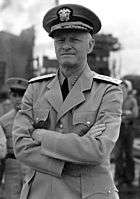
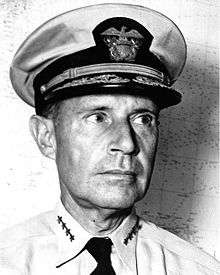
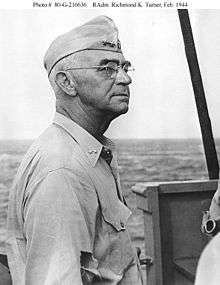

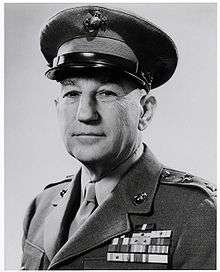

Naval
The roles of Commander in Chief, Pacific Ocean Areas (CINCPOA) and Commander in Chief, U.S. Pacific Fleet (CINCPAC), were both exercised by Admiral Chester W. Nimitz from his headquarters at Pearl Harbor, Hawaii.
Since the Gilberts and Marshalls lie in the Central Pacific, their capture was the responsibility of the U.S. Fifth Fleet, led by Vice Admiral Raymond A. Spruance from aboard his flagship, heavy cruiser Indianapolis.
The ships and troops of Operations Galvanic (landings on Tarawa Atoll) and Kourbash (landings on Makin Atoll) were under direct operational command of Rear Admiral Richmond Kelly Turner aboard battleship Pennsylvania.
In case Admiral Mineichi Koga attempted to disrupt Fifth Fleet's operations, Spruance was to strip all combat ships not needed to cover the landings, join with the fast carrier forces and engage the Japanese. In the event, Koga's Combined Fleet never stirred from its anchorage at Truk Lagoon in the Carolines.
Ground troops
V Amphibious Corps (Maj. Gen. Holland M. Smith, USMC)
- Tarawa: 2nd Marine Division (Maj. Gen. Julian C. Smith, USMC)
- Makin: 27th Infantry Division (Army) (Maj. Gen. Ralph C. Smith, USA)
Both Admiral Turner and General Holland Smith sailed with the Northern Attack Force even though it was obvious that Tarawa would be the scene of the main ground action. If the Japanese mounted a counterattack, it was most likely to come from the Marshalls since the closest Japanese bases to the Gilberts were located there. Nimitz and Spruance wanted the two highest-ranking officers to sail with the forces that would be the first to encounter any such enemy response. Unbeknownst to the Americans, the Japanese had stripped almost all their naval and air assets from the Marshalls in an attempt to resist the Allied effort in the Central Solomons. Thus, no counterattack materialized.[1]
TF 50 Carrier Force
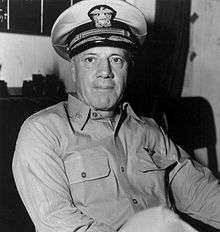
Rear Adm. Charles A. Pownall in Yorktown
TG 50.1 Carrier Interceptor Group
Rear Adm. Charles A. Pownall in Yorktown
2 Fleet Carriers:
- Yorktown CV-10 (Capt. J. J. Clark)
- Air Group 5 (Lt. Cmdr. C. L. Crommelin):
- 36 Grumman F6F-3 Hellcats (VF-5 – Lt. Cmdr. E M. Owen)
- 36 Douglas SBD-5 Dauntlesses (VB-5 – Lt. Cmdr. E. E. Stebbins)
- 18 Grumman TBF-1 Avengers (VT-5 – Lt. Cmdr. R. Upson, USNR)
- Air Group 5 (Lt. Cmdr. C. L. Crommelin):
- Lexington CV-16 (Capt. F. B. Stump)
- Air Group 16 (Lt. Cmdr. E. M. Snowden):
- 36 Grumman F6F-3 Hellcats (VF-16 – Lt. Cmdr. P. D. Buie)
- 36 Douglas SBD-5 Dauntlesses (VB-16 – Lt. Cmdr. Snowden)
- 18 Grumman TBF-1 Avengers (VT-16 – Lt. Cmdr. R. H. Isely)
- Air Group 16 (Lt. Cmdr. E. M. Snowden):
1 Light Carrier:
- Cowpens CVL-25 (Capt. R. P. McConnell)
- Air Group 25 (Lt. R. H. Price):
- 24 Grumman F6F-3 Hellcats (VF-25 – Lt. Price)
- 12 Grumman F6F-3 Hellcats (VF-6 – Lt. G. C. Bullard)
- 10 Grumman TBF-1 Avengers (VC-25 – Lt. Cmdr. M. A. Grant)
- Air Group 25 (Lt. R. H. Price):
Battleship Division 6 (Rear Adm. E. W. Hanson):
- 2 New Battleships – Washington BB-56 (Capt. J. E. Maher); South Dakota BB-57 (Capt. A. E. Smith)
Screen (Lr. Cmdr. A. J. Hill):
- 6 Fletcher Class Destroyers – La Vallette DD-448 (Lt. Cmdr. R. L. Taylor); Nicholas DD-449 (Cmdr. R. T. S. Smith); Taylor DD-468 (Lt. Cmdr. B. Katz); Charrette DD-581 (Cmdr. E. S. Karpe); Conner DD-582 (Cmdr. W. E. Kaitner); Izard DD-589 (Lt. Cmdr. E. K. Van Swearingen)
TG 50.2 Northern Carrier Group
Rear Adm. Arthur W. Radford in Enterprise
1 Fleet Carrier:
- Enterprise CV-6 (Capt. S. P. Ginder)
- Air Group 6 (Lt. Cmdr. E. H. O'Hare) (killed 26 Nov):
- 36 Grumman F6F-3 Hellcats (VF-2 – Lt. Cmdr. W. A. Dean)
- 36 Douglas SBD-5 Dauntlesses (VB-6 – Lt. Cmdr. I. M. Hampton)
- 18 Grumman TBF-1 Avengers (VT-6 – Lt. Cmdr. J. L. Phillips)
- Air Group 6 (Lt. Cmdr. E. H. O'Hare) (killed 26 Nov):
2 Light Carriers:
- Belleau Wood CVL-24 (Capt. A. M. Pride)
- Air Group 24 (Cmdr. R. H. Dale):
- 26 Grumman F6F-3 Hellcats (VF-24 – Cmdr. Dale)
- 12 Grumman F6F-3 Hellcats (VF-6 – Lt. P. C. Rooney)
- 9 Grumman TBF-1 Avengers (VC-22B – Lt. R. M. Swenson)
- Air Group 24 (Cmdr. R. H. Dale):
- Monterey CVL-26 (Capt. L. T. Hundt):
- Air Group 30 (Lt. Cmdr. J. G. Sliney, USNR):
- 24 Grumman F6F-3 Hellcats (VF-30 – Lt. Cmdr. Sliney)
- 9 Grumman TBF-1 Avengers (VC-30 – Lt. Cmdr. J. D. Black)
- Air Group 30 (Lt. Cmdr. J. G. Sliney, USNR):
Battleship Division 6 (Rear Adm. G. B. Davis):
- 3 New Battleships – North Carolina BB-55 (Capt. F. P. Thomas); Indiana BB-58 (Capt. W. M. Fechteler); Massachusetts BB-59 (Capt. T. D. Ruddock)
Screen (Cmdr. H. F. Miller):
- 6 Fletcher Class Destroyers – Fletcher DD-445 (Lt. Cmdr. R. D. McGinnis); Radford DD-446 (Cmdr. G. E. Griggs); Jenkins DD-447 (Lt. Cmdr. M. Hall); Boyd DD-544 (Lt. Cmdr. U. S. G. Sharp); Bradford DD-545 (Lt. Cmdr. R. L. Morris); Brown DD-546 (Lt. Cmdr. T. H. Copeman)
TG 50.3 Southern Carrier Group
Rear Adm. Alfred E. Montgomery in Essex
2 Fleet Carriers:
- Essex CV-9 (Capt. D. B. Duncan)
- Air Group 9 (Cmdr. J. Raby):
- 36 Grumman F6F-3 Hellcats (VF-9 – Lt. Cmdr. P. H. Torrey)
- 36 Douglas SBD-5 Dauntlesses (VB-9 – Lt. Cmdr. A. T. Decker)
- 18 Grumman TBF-1 Avengers (VT-9 – Lt. Cmdr. P. E. Emrick)
- Air Group 9 (Cmdr. J. Raby):
- Bunker Hill CV-17 (Capt. J. J. Ballentine)
- Air Group 17 (Cmdr. M. P. Bagdanovitch):
- 36 Grumman F6F-3 Hellcats (VF-18 – Lt. Cmdr. S. L. Silber, USNR)
- 32 Curtiss SB2C-1 Helldivers (VB-17 – Lt. Cmdr. J. E. Vose)
- Air Group 17 (Cmdr. M. P. Bagdanovitch):
1 Light Carrier:
- Independence CVL-22 (Capt. R. L. Johnson)
- Air Group 22 (Cmdr. J. M. Peters):
- 16 Grumman F6F-3 Hellcats (VF-22 – Lt. J. J. Johnson, USNR)
- 12 Grumman F6F-3 Hellcats (VF-6 – Lt. Cmdr. H. W. Harrison, USNR)
- 9 Grumman TBF-1 Avengers (VC-22 – Cmdr. Peters)
- Air Group 22 (Cmdr. J. M. Peters):
Cruiser Division 5 (Rear Adm. E. G. Small):
- 3 Heavy Cruisers – Pensacola CA-24 (Capt. R. E. Dees); Salt Lake City CA-25 (Capt. W. L. Busbey); Chester CA-27 (Capt. F. T. Spellman)
- 1 AA Light Cruiser – Oakland CL-95 (Capt. W. K. Phillips)
Screen (Capt. J. T. Bottom):
- 5 Fletcher Class Destroyers – Erben DD-631 (Cmdr. J. H. Nevins); Hale DD-642 (Cmdr. K. F. Poehlman), Bullard DD-660 (Lt. Cmdr. B. W. Freund); Kidd DD-661 (Lt. Cmdr. A. B. Roby); Chauncey DD-667 (Lt. Cmdr. L. C. Conwell)
TG 50.4 Relief Carrier Group
Rear Adm. Frederick C. Sherman in Saratoga
1 Fleet Carrier:
- Saratoga CV-3 (Capt. J. H. Cassady)
- Air Group 3 (Cmdr. H. H. Caldwell):
- 37 Grumman F6F-3 Hellcats (VF-12 – Cmdr. J. C. Clifton)
- 24 Douglas SBD-5 Dauntlesses (VB-12 – Lt. Cmdr. J. H. Newell)
- 18 Grumman TBF-1 Avengers (VT-12 – Lt. Cmdr. R. F. Farrington)
- Air Group 3 (Cmdr. H. H. Caldwell):
1 Light Carrier:
- Princeton CVL-23 (Capt. G. R. Henderson)
- Air Group 23 (Lt. Cmdr. H. L. Miller):
- 24 Grumman F6F-3 Hellcats (VF-23 – Lt. Cmdr. Miller)
- 9 Grumman TBF-1 Avengers (VT-23 – Lt. Cmdr. M. T. Hatcher)
- Air Group 23 (Lt. Cmdr. H. L. Miller):
Cruiser Division 2 (Rear Adm. L. J. Wiltse):
- 2 AA Light Cruisers – San Diego CL-53 (Capt. L. J. Hudson); San Juan CL-54 (Capt. G. W. Clark)
Screen:
- 3 Gridley Class Destroyers – Stack DD-406 (Lt. Cmdr. P. K. Sherman); Sterett DD-407 (Lt. Cmdr. F. G. Gould); Wilson DD-408 (Lt. Cmdr. C. K. Duncan);
- 1 Benson Class Destroyers – Edwards DD-619 (Lt. Cmdr. P. G. Osler)
TF 52 Northern Attack Force (Makin)

Rear Adm. Richmond Kelly Turner in Pennsylvania
TG 52.1 Transport Group
Capt. D. W. Loomis
165th Regimental Combat Team and 105th Battalion Landing Team of the 27th Division (Major General Ralph C. Smith, USA)
4 Attack Transports:
- Neville APA-9 (Cmdr. O. R. Swigart); Leonard Wood APA-12 (Capt. M. O'Neil, USCG); Calvert APA-32 (Cmdr. E. J. Sweeney, USNR); Pierce APA-50 (Cmdr. A. R. Ponto)
1 Attack cargo ship:
- Alcyone APA-7 (Cmdr. J. B. McVey)
1 Landing ship dock:
- Belle Grove LSD-2 (Lt. Cmdr. M. Seavey, USNR)
Screen:
- 1 Farragut Class Destroyer – Dale DD-353 (Lt. Cmdr. C. W. Aldrich)
- 1 Sims Class Destroyer – Mustin DD-413 (Cmdr. M. M. Riker)
- 2 Fletcher Class Destroyers – Kimberly DD-521 (Lt. Cmdr. Harry Smith); Burns DD-588 (Lt. Cmdr. D. T. Eller)
TG 52.2 Fire Support Group
Rear Adm. Robert M. Griffin in New Mexico
Unit 1:
- 2 Old Battleships – Pennsylvania BB-38 (Capt. W. A. Corn); New Mexico BB-40 (Capt. E. M. Zacharias)
- 2 Heavy Cruisers – Minneapolis CA-36 (Capt. R. W. Bates); San Francisco CA-38 (Capt. A. F. France)
- 2 Farragut Class Destroyers – Dewey DD-349 (Lt. Cdr. J. P. Canty); Hull DD-350 (Lt. Cmdr. A. L. Young)
Unit 2:
- 2 Old Battleships – Mississippi BB-41 (Capt. L. L. Hunter); Idaho BB-42 (Capt. H. D. Clarke)
- 2 Heavy Cruisers – New Orleans CA-32 (Capt. S. R. Shumaker); Baltimore CA-68 (Capt. W. C. Calhoun)
- 2 Gridley Class Destroyers – Gridley DD-380 (Lt. Cmdr. J. H. Motes); Maury DD-401 (Lt. Cmdr. J. W. Koenig)
Unit 3:
- 1 Farragut Class Destroyer – MacDonough DD-351 (Lt. Cmdr. J. W. Ramey)
- 1 Porter Class Destroyer – Phelps DD-360 (Lt. Cmdr. J. E. Edwards)
TG 52.3 Air Support Group
Rear Adm. Henry M. Mullinnix (killed 24 Nov) in Liscome Bay
3 Escort Carriers:
- Liscome Bay CVE-56 (sunk 24 Nov) (Capt. I. D. Wiltsie) (killed 24 Nov)
- Air Group (Lt. Cmdr. M. U. Beebe):
- Coral Sea CVE-57 (Capt. H. W. Taylor)
- Air Group (Lt. Cmdr. J. J. Lynch):
- Corregidor CVE-58 (Capt. R. L. Bowman)
- Air Group (Lt. Cmdr. G. M. Clifford):
Screen:
- 2 Sims Class Destroyers – Hughes DD-410 (Lt. Cmdr. E. B. Rittenhouse); Morris DD-417 (Cmdr. F. T. Williamson)
- 2 Fletcher Class Destroyers – Hoel DD-533 (Cmdr. W. D. Thomas); Franks DD-554 (Cmdr. N. A. Lidstone)
- 1 Raven class Minesweeper – Revenge AM-110 (Cmdr. F. F. Sima, USNR)
TG 54.4 Makin LST Group No. 1
Cmdr. A. M. Hurst
- 3 Landing Ship Tanks – 31, 78, 178, each carrying an LCT
- 1 Farragut Class Destroyer – Dale DD-353 (Lt. Cmdr. C. W. Aldrich)
TF 53 Southern Attack Force (Tarawa)

Rear Adm. Harry W. Hill in Maryland
TG 53.1 Transport Group
Capt. H. B. Knowles in Monrovia
2nd Marine Division, reinforced (Maj. Gen. Julian C. Smith, USMC)
Transport Division 4 (Capt. J. B. McGovern):
- 5 Attack Transports – Zeilin APA-3 (Cmdr. T. B. Fitzpatrick); Heywood APA-6 (Cmdr. P. F. Dugan); William P. Biddle APA-8 (Cmdr. L. F. Brown, USNR); Harry Lee APA-10 (Cmdr. J. G. Pomeroy); Arthur Middleton APA-25 (Cmdr. P. K. Perry, USCG)
Transport Division 6 (Capt. T. B. Brittain):
- 4 Attack Transports – Harris APA-2 (Cmdr. A. M. Van Eaton); Feland APA-11 (Cmdr. C. A. Mission); J. Franklin Bell APA-16 (Cmdr. O. H. Ritchie, USNR); Ormsby (APA-49) (Cmdr. L. Frisco)
Transport Division 18 (Capt. Knowles):
- 3 Attack Transports – Doyen APA-1 (Cmdr. J. G. McClaughry), Monrovia APA-31 (Cmdr. J. D. Kelsey); Sheridan APA-51 (Cmdr. J. J. Mockrish, USNR)
- 3 Attack Cargo Ships – Bellatrix AKA-3 (Cmdr. C. A. Jones); Thuban AKA-19 (Cmdr. J. C. Campbell); Virgo AKA-20 (Cmdr. C. H. McLaughlin, USNR)
- 1 Landing Ship Dock – Ashland LSD-1 (Cmdr. C. L. C. Atkeson)
- 1 Transport – La Salle AP-102 (Cmdr. F. C. Fleugel, USNR)
Screen (Capt. E. M. Thompson)
- 7 Fletcher Class Destroyers – Sigsbee DD-502 (Cmdr. B. V. M. Russell); Hazelwood DD-531 (Cmdr. H. Wood); Heermann DD-532 (Cmdr. D. M. Agnew); Harrison DD-573 (Lt. Cmdr. C. M. Dalton); John Rodgers DD-574 (Cmdr. H. O. Parish); McKee DD-575 (Cmdr. J. J. Greytak); Murray DD-576 (Cmdr. P. R. Anderson)
TG 53.2 Minesweeper Group
Lt. Cmdr. H. R. Peirce
- 2 Raven class Minesweepers – Pursuit AM-108 (Lt. R. F. Good); Requisite AM-109 (Lt. Cmdr. Peirce)
TG 53.4 Fire Support Group
Rear Adm. Howard F. Kingman
Section 1:
- 1 Old Battleship – Tennessee BB-43 (Capt. R. S. Haggart)
- 1 Light Cruiser – Mobile CL-63 (Capt. C. J. Wheeler)
- 2 Benson Class Destroyers – Bailey DD-492 (Lt. Cmdr. M. T. Munger); Frazier DD-607 (Lt. Cmdr. E. M. Brown)
Section 2 (Rear Adm. L. T. DuBose):
- 1 Old Battleship – Maryland BB-46 (Capt. C. H. Jones)
- 1 Light Cruiser – Santa Fe CL-60 (Capt. R. S. Berkey)
- 2 Benson Class Destroyers – Meade DD-602 (Lt. Cmdr. J. Munholland); Gansevoort DD-608 (Lt. Cmdr. M. L. McCullough)
Section 3:
- 1 Old Battleship – Colorado BB-45 (Capt. W. Granat)
- 1 Heavy Cruiser – Portland CA-33 (Capt. A. D. Burhans)
- 2 Sims Class Destroyers – Anderson DD-411 (Lt. Cmdr. J. G. Tennent); Russell DD-414 (Lt. Cmdr. W. H. McClain)
Section 4 (Cmdr. H. Crommelin):
- 2 Fletcher Class Destroyers – Ringgold DD-500 (Cmdr. T. F. Conley); Dashiell DD-659 (Cmdr. J. B. McLean)
Section 5:
- 1 Heavy Cruiser – Indianapolis CA-35 (Capt. E. R. Johnson)
- 1 Fletcher Class Destroyer – Schroeder DD-501 (Lt. Cmdr. J. T. Bowers)
TG 53.6 Air Support Group
Rear Adm. V. H. Ragsdale
5 Escort Carriers:
- Sangamon CVE-26 (Capt. E. P. Moore)
- 12 Grumman F6F-3 Hellcats (Lt. Cmdr. F. L. Bates)
- 9 Douglas SBD-5 Dauntlesses (Lt. Cmdr. B. E. Day)
- 9 Grumman TBF-1 Avengers
- Suwanee CVE-27 (Capt. F. W. McMahon)
- 12 Grumman F6F-3 Hellcats (Lt. Cmdr. H. O. Harvey)
- 9 Douglas SBD-5 Dauntlesses
- 9 Grumman TBF-1 Avengers (Lt. Cmdr. A. C. Edmands)
- Chenango CVE-28 (Capt. D. Ketcham)
- 12 Grumman F6F-3 Hellcats (Lt. Cmdr. S. Mandarich)
- 9 Douglas SBD-5 Dauntlesses
- 9 Grumman TBF-1 Avengers (Lt. Cmdr. R. L. Flint, USNR)
- Nassau CVE-16 (Capt. S. J. Michael)
- 12 Grumman F6F-3 Hellcats (Lt. Cmdr. B. N. Strean)
- Barnes CVE-20 (Capt. G. A. Dussault)
- 12 Grumman F6F-3 Hellcats (Lt. Cmdr. Strean)
Screen:
- 3 Farragut Class Destroyers – Farragut DD-348 (Lt. Cmdr. E. F. Ferguson); Monaghan DD-354 (Lt. Cmdr. P. H. Horn); Aylwin DD-355 (Cmdr. R. O. Strange)
- 2 Fletcher Class Destroyers – Cowell DD-547 (Cmdr. C. W. Parker); Cotten DD-669 (Lt. Cmdr. F. T. Sloat)
TG 54.5 Tarawa LST Group No. 1
Lt. Cmdr. R. M. Pits
- 3 Landing Ship Tanks – 34, 242, 243, each carrying an LCT
- 1 Benson Class Destroyer – Bancroft DD-598 (Lt. Cmdr. Pits)
References
- ↑ Wright, Tarawa 1943: The Turning of the Tide, p. 22